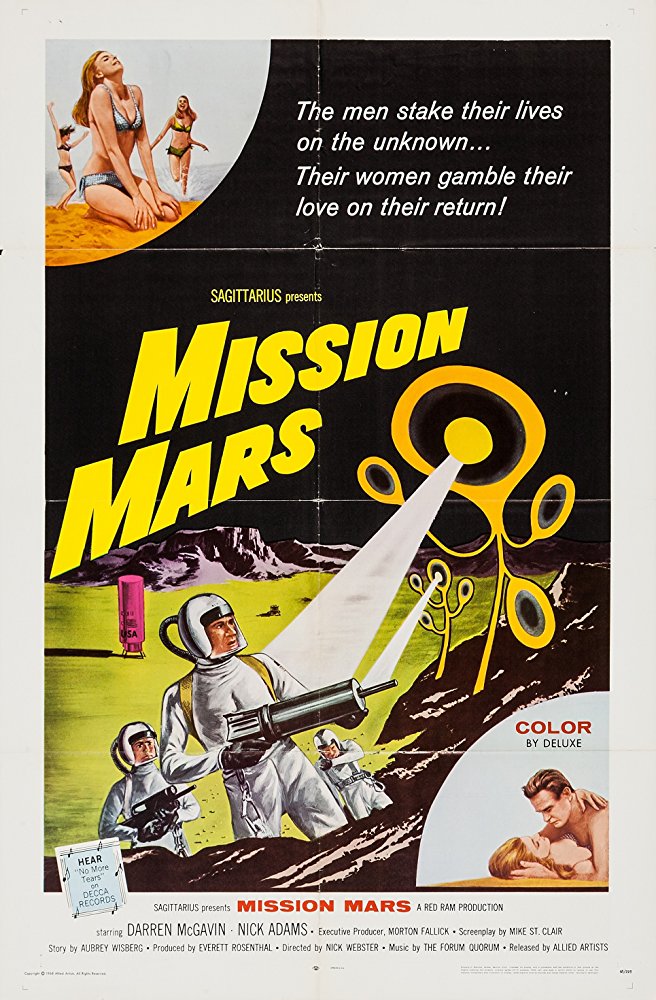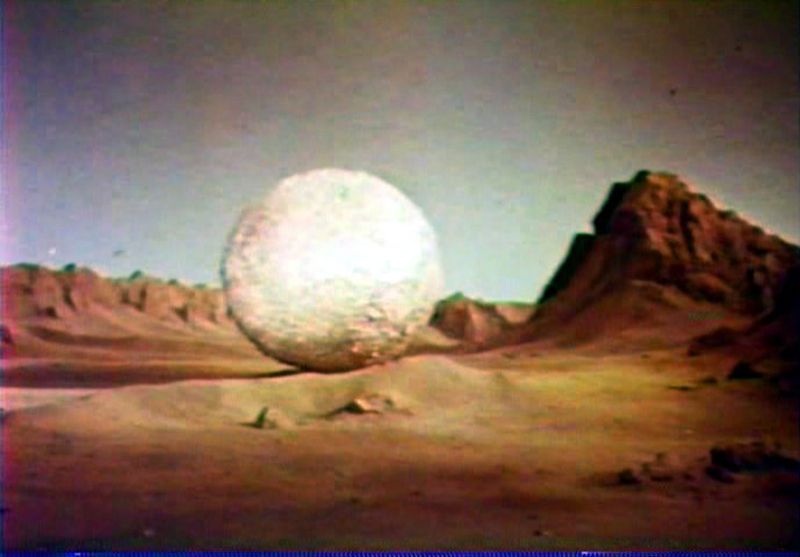The IMDb metadata is 1 hour and 35 minutes run time, rated 4.7 by scant 200 cinemitizens.

Verdict: Not even Carl Kolchak could save this one.
Three American astronauts blast-off for the Red Planet (quite visible of late), but before that about twenty minutes is devoted to their wives and girlfriends telling them each to be careful. Nearly the same dialogue is repeated three times by the women. That astronauts have lives and cares is certainly worth screen time but the repetition makes it irritating rather than engaging. Each of the women give it their best shot. The problem is not the singers but the song.
The flyboys blast-off and the early going has some verisimilitude, though the shots slide between a Jupiter and Atlas rockets in NASA stock footage of Florida launches. The fraternity brothers are up on rockets and spotted this gaffe. Our heroes encounter the usual screenwriting tropes of communication blackouts, meteor showers, and body odour. Darren McGavin and Nick Adams do their best to make it credible.
There is also an amusing moment when McGavin and the third member of the crew, who the fraternity brothers immediately identified as a dispensable Red Shirt, tuck into a meal of pellets and brine, while Adams produces from his kit a salami sandwich and thermos of coffee. They are appalled, aghast, and envious all at once. One of the few nice touches in this turgid celluloid.
Nearing Mars, they pass, floating in the void of space, two dead spacesuited Soviet cosmonauts. Gulp! That gives them pause for thought about a fate that might await them in the screenplay. This encounter ties up an earlier aside about Soviet interest in Mars. So far, so usual.
In the approach for landing they take actions that separate them from the supply canister that was to accompany their landing. ‘We’ll find it later,’ says McGavin. We know what that means. Trouble.
They land and alight with no ceremony or awe. Just a remark to the effect that ‘So this is Mars.’ They spend hours, well so it seemed, pumping up weather balloons for scientific reasons unknown. To find the supply pod they scout around. Yep. While they have on white overalls, their face masks came from a hockey team and do not seal into the overalls.
Soon enough the local flora and fauna objects to their presence: Terra Nullius or not. The Red Shirt in the crew of three is gobbled up by a large golf ball.
 This orb looks very much like the enlargement John Carradine used in ‘The Cosmic Man’ (1959), reviewed elsewhere on this blog.
This orb looks very much like the enlargement John Carradine used in ‘The Cosmic Man’ (1959), reviewed elsewhere on this blog.
They find a third Soviet cosmonaut frozen in a spacesuit. ‘We can’t leave him here,’ McGavin says. (He gets all the good lines.) Gamely Nick Adams carries the frozen Soviet block of ice back to the ship. The fraternity brothers were pretty sure leaving the Red there was just fine, and how could little Nick carry that big Slav with all his gear to the ship anyway. That attitude just proves why they will never graduate from scriptwriting school.
The bug-eyed saplings and gigantic tin foil wrapped golf ball cripple the ship making departure impossible. Stop there and check the Vulcan logic.
The FF (flora or fauna, the fraternity brothers could not tell which was which and neither could the special effects department) wants the strangers gone. How to do that? Disable the ship so they have to stay. Check. That is scriptwriting school logic, Mr Spock. It is to be seen in countless other Sy FY features like ‘Forbidden Planet’ (1956), reviewed elsewhere on this blog.
The Siberian thaws out and comes to life while Nick goes to tee-off on the golf ball, nine iron in hand. Bad move. That Reynolds Wrap tin foil is club-proof. Gobble. Gobble.
However, while the golf ball is masticating Nick, McGavin sees his chance to blast off and puts the Siberian at a console to twist dials. Dials twisted. Kaboom. They take off in joint American-Soviet effort at escape. For the time that is a concession to the unity of mankind in the face of mean plants.
The end. Well, I stopped watching, ahem, maybe earlier, too.
The story and production come straight from a 1950s B movie, yet it was released in the same year as ‘Space Odyssey 2001.’ It seems all the more dated when one realises that in less than a year the audience would see on the television news a man walking on the Moon.
The early going and the end are marred by an insipid soundtrack that has no connection to either the form or content of the movie. The producer must have had an aspiring musician in the extended family.
It was made in Miami and the supporting actors in the cast were evidently local talent, not the familiars of Hollywood. That does give it a freshness but it is soon lost in the early repetitions.
This same director’s oeuvre includes ‘Santa Claus Conquers the Martians’ (1964), not reviewed on this blog, yet. But only because I have been unable to locate it online.
Skip to content
